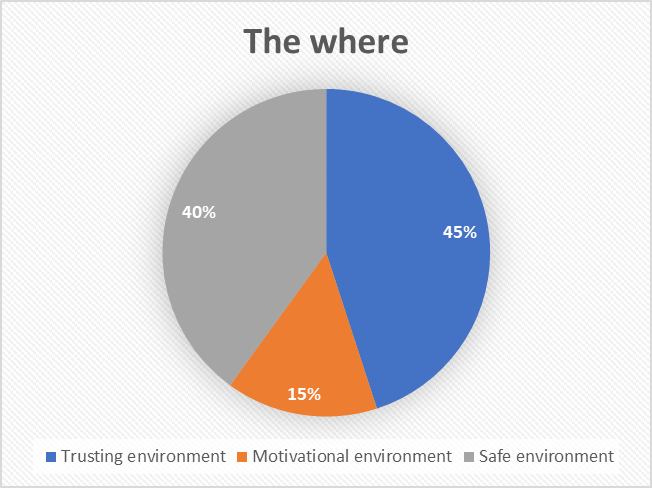Just another blog on High Performing Teams
Recently I have had the privilege of being able to do a small bit of local research on the topic of High Performing teams. It’s a topic that can galvanise many conversations and has many opinions. Indeed if you google this term there are plethora of articles discussing this very topic.
Even the definition itself of what a High Performing Team (HPT) is is varied and although you may find similarities between such definitions, you will also note differences, enough that a single consensus on this subject is hard to obtain.
This article is not an attempt to completely define what a HPT is (although I do give my thoughts based on the findings) as there have been multiple studies done and research on this topic (I list a few at the end of this article). However what I do wish to outline is what this topic might mean for the people I work with and so identify potential differences or similarities to other studies.
Why?
When I first started working at my current job about 8 months ago I heard the topic of a High performing team mentioned in various discussions. This has always been an interest of mine since then, on what exactly did people mean when they said this, and are we all thinking the same thing. If in fact we were all a high performing in a team environment that is great and I was excited to be a part of that. However on the flip side, it’s ok also if we are not and it’s something worth continually aiming for.
I’m not interested in winners or losers on this topic, but instead wanted to bring clarity and honesty for teams where I work and use the goal of HPT as a means to elicit good conversations, good learning opportunity and good engagement with each other.
My challenge to those reading this
I challenge anyone reading this to do this exercise yourself, or with your own team. Or feel free to use this information to further retrospect their own journey to being a High Performing team and hold honest and robust conversations on this topic. In fact the ability to do this is one of the areas identified as contributing to a HPT itself. Then by documenting the outcomes of these discussions you can have continual bench-marks for reflection and self analysis as a team for continual growth. Don’t just talk about it, BE in that team that show’s to everyone else where you are at on your HPT journey!
Possible definitions of a High Performing Team
Using google to help with research on this, you will find many varied definitions on what an HPT could mean. One such definition can be found from the Leadership Garden.
“A high-performance team is a cross-functional group of people with complementary skills. They are aligned with and committed to shared values and vision and work towards a common objective.
There is deep trust and mutual respect among the team members.
This highly effective team is innovative in problem-solving and displays a high level of communication and collaboration, delivering consistent and superior results.
High-performing teams meet their goals consistently, work cohesively as a group, and are engaged in their work” – Leadership Garden
My own summary that I came up with after viewing the results of this study is something like (see note below for caveat to this):
“A group of motivated and competent individuals who have clarity around Why and What they are delivering and can deliver value as a team with-in an Environment that promotes performance. It’s noted that rarely does an HPT reach it’s Everest but that continual growth and learning means for-ever striving for that moving target” – Andre
Note: Given the nature of a HPT, the definition in and of itself does not matter, if it does not make sense to the you. The discussions and review of this topic within your scrum teams will help form base reference points from which to grow and reflect going forward. In order to grow, we must first have a starting point, and to move in the right direction a target end point needs to be identified.
Results
The survey conducted had 30 people provide their opinions and thoughts on this subject. The sample pool consisted of Engineers, SDM’s, BA’s, SM and Architects. It’s important to note that I did not seek information on gender, ethnicity or age as did not consider this relevant to the results. I did collect information on a persons role however found that this had little bearing to the overall results.
In total there were around 175 comments received as well as a handful of related articles (see Appendix below). Upon analysis of the data and help with the team Scrum Masters we were able to identify 4 key areas that contributed to our thoughts on what makes a HPT.
The why and the what (12%)
Interest in this grouping focused on comments around having clear understanding on why we are building what we are building as well as an appreciation on ensuring we deliver the right thing. A strong theme in this area was around having a true appreciation into the product or solution being built providing people with a sense of purpose and happiness knowing their hard work is paying off.
- Delivering the right thing, Clarity
The How (36%)
One of the biggest areas in regards to comments provided was this area “The How”. How do go about their work and get things done. One of the most highly commented attributes was Communication and collaboration with people especially interested in members showing “Team first” attitudes and clear communication between team members. This indicated that people considered interaction between team members to be of high importance when it comes to HPT. What wasn’t determined was what does communication mean for a team and how do we go about creating Effective communication. This could vary from team to team and so understanding what this means at a team level would help strengthen their journey towards HPT.
- Predictability, Getting stuff done, Being flexible, Collaboration, Sharing, Communication
The Who (29%)
The 2nd most contributed area for creating a High performing team was who made up the teams. Having clear roles and expectations among team members was important. As was individual team member growth and competence. These were all recognised as important characteristics for HPT. Autonomy was also highlighted as as a contributing factor, however the definition of Autonomy is something that could be explored in further detail.
- Growth, Roles and Expectations, Competence, Autonomy
The Where (23%)
There was a strong commonality of theme in this grouping around having a great environment to work in. This included three key aspects of being Motivated, Trusting and feeling Safe. Having an environment that exuded these characteristics would enable engineers to grow and perform with confidence. During the analysis the Scrum masters determined that there was tight correlation between the Who and the Where with people creating distinction on the environment they work in not just being physical but also a culture they feel they can thrive in.
- Trusting, Motivational and Safe Environment
Other themes
A strong underlying theme that did show through in the survey and is strongly re-enforced by other articles on this subject is that of Psychological safety. Because of that, I feel it’s worth-while noting this and letting each team draw their own conclusions and have discussions on the subject.
Psychological safety
This characteristic of HPT was a cross cutting underlying characteristic across many of the groups identified above and show’s it’s importance in contributing to a high performing team. In order for individuals and then teams to reach full potential, they need to be in an environment that feels safe and free for them to discuss ideas, push the boundaries of what’s possible and in doing so make mistakes and learn from them. It is important to note though that this does not give licence to make continual mistakes that are both detrimental and hurtful to a team’s performance. Rather the ability to try things, reflect in a safe way and then grow as a individual and team to continue to the next part of their HPT journey.
Some possible definitions of Psychological safety include:
“Psychological safety is the ability to show and employ one’s self without fear of negative consequences of self-image, status or career. In the workplace, it is a shared belief held by members of a company, department or team that the team is safe for interpersonal risk-taking” – Forbes
“Psychological safety is the ability to show and employ oneself without fear of negative consequences of self-image, status, or career (Kahn 1990, p. 708).[1] It can be defined as a shared belief that the team is safe for interpersonal risk taking.[2] In psychologically safe teams, team members feel accepted and respected. It is also the most studied enabling condition in group dynamics and team learning research” – Wiki
“It’s a shared belief held by members of a team that others on the team will not embarrass, reject, or punish them for speaking up” – Center for Creative Leadership
Team
Whilst reviewing the survey results I also had some time to reflect on what constitutes a team and how that fits in to a multi tiered departmental organisation. A definition of a team from Asana states that:
“Teamwork in the workplace is when a group of individuals works together toward a collective goal in an efficient manner. When multiple people work together toward a common goal, your business can flourish” – Asana
I noticed this does not specify how big a team is, or whether it’s cross functional or cross departmental. Neither does it state the exact make-up of a team. And a challenge to build a full high performing team is not just building it at the lowest level, but creating a HPT at all layers of an organisational setup. Your role at each layer may also change, as well as the expectations and output of the team at each layer.
Recognising that a High Performing Team can mean one thing for the people within the team and something different to those looking from the outside, depending on what their definition of a team is.
Approach
The survey was conducted in two parts. The main data collection was done via Google forms with the recipient details being anonymous. Further collection of data was done via individual requests to selected recipients from a number of different practices.
Included in the survey was research into existing information on High Performing Teams some of which can be found in the Appendix.
Once all the data was collected a I did an exercise using groups from Googles re:Work study as a starting reference point. However upon reflection it was considered that this approach was influenced too much by external articles and so a further session was held by a team of Scrum Masters to make groupings that would be more relevant to Digital Engineering.
Once this grouping was finalised, statistics were collected identifying the number of comments per group to gain insight to some of the importance or popularity of the information received.
Reviewers
There have been many contributors to this survey and results and thanks goes out to everyone who helped put it together:
- Peers – For initial feedback/thoughts on the process and exceptional grammar corrections
- Scrum masters – For their awesome analysis of the results and subsequent work with teams to produce insight and reflection within teams
- Survey participants – For providing some great information and insight into what people consider contributes towards a High Performing Team in our organisation
Appendix 1 – Resources
Google re:Work :: Study implemented by google in addressing this topic
Leadership Garden :: Definitions of a high performing team
Microsoft article: 5 attributes of high performing team
Coffee example :: I love my job
Harvard Business Review :: 5 things HPT just do differently
Simple learning :: The secret reciple to building High Performing teams
David Burkus :: 4 Characteristics of High Performing Teams
Hive :: High-Performing teams do these 9 things differently
Microsoft :: The psychology of high-performing teams
Performing vs Performers :: The difference between high performing team and high performers




